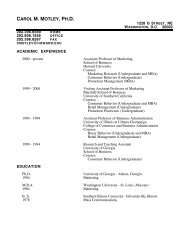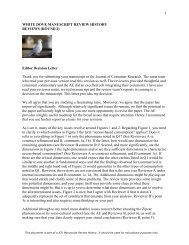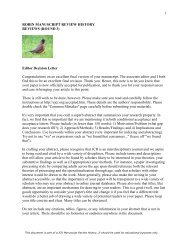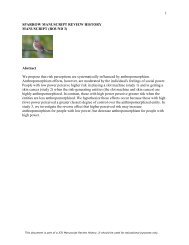Why Happiness Helps You See the Big Picture - Journal of ...
Why Happiness Helps You See the Big Picture - Journal of ...
Why Happiness Helps You See the Big Picture - Journal of ...
Create successful ePaper yourself
Turn your PDF publications into a flip-book with our unique Google optimized e-Paper software.
Copyright <strong>Journal</strong> <strong>of</strong> Consumer Research 2008.<br />
Preprint (not formatted or copyedited).<br />
Do not quote or cite without permission.<br />
6<br />
In contrast, when we regressed positivity index onto cue and included <strong>the</strong> construal index<br />
as a covariate (cue construal positivity), we observed a significant effect <strong>of</strong><br />
construal (ß = .61, SE = .16; t(57) = 3.81, p < .01) but not <strong>of</strong> cue (ß = .03, SE = .05; t(57)<br />
< 1). Thus, <strong>the</strong> effect <strong>of</strong> cue on positivity <strong>of</strong> response was mediated by construal level<br />
(Sobel z = 3.13, p < .01), but positive cues evoked abstract construal independent <strong>of</strong><br />
positivity <strong>of</strong> response. Presumably, if <strong>the</strong> situation feels benign, psychological distancing<br />
and seeing <strong>the</strong> big picture is independent <strong>of</strong> additional positive information coming to<br />
mind, but psychological distancing brings additional positive information to mind.<br />
The finding that abstract construal increases positivity <strong>of</strong> responses is compatible<br />
with <strong>the</strong> literature. For example, Vallacher and Wegner (1987) demonstrate that difficulty<br />
(ease) or feelings that actions are going poorly (well) are associated with low-level (highlevel)<br />
construal. In addition, Eyal and colleagues (2004) demonstrate that an abstract (vs.<br />
concrete) construal leads to a greater focus on pros or positive arguments, and positive<br />
arguments might correspond with a positive mood. We show that positive cues activate<br />
abstract construal and that this is not because <strong>the</strong> associations with <strong>the</strong> cues are positive.<br />
Importantly, neutral-condition participants were somewhat more concrete than abstract,<br />
indicating that it is unlikely that <strong>the</strong> items included in <strong>the</strong> list were somehow more<br />
compatible with abstract construal. In summary, experiment 1a demonstrates that positive<br />
cues evoke an abstract construal. Experiment 1b tests whe<strong>the</strong>r manipulated mood also<br />
evokes construal level and results in similar effects.<br />
EXPERIMENT 1B: MOOD AND CONSTRUAL LEVEL<br />
Experiment 1b is similar to experiment 1a, except that instead <strong>of</strong> associating<br />
bullet points with Vallacher and Wegner’s (1989) questionnaire items, we manipulated<br />
participant’s mood before <strong>the</strong>y completed a survey. We used three different replications<br />
<strong>of</strong> <strong>the</strong> construal task: Vallacher and Wegner’s open-ended survey and <strong>the</strong>ir forced-choice<br />
survey and an adaptation <strong>of</strong> Peterson and colleagues’ (1982) attribution style<br />
questionnaire.<br />
Method<br />
One hundred twenty-nine undergraduate students at <strong>the</strong> University <strong>of</strong> Georgia<br />
participated in an in-class experiment on consumer decision making. Participants were<br />
randomly assigned to a positive- or negative-mood condition and completed two<br />
purportedly unrelated questionnaires. The first task was <strong>the</strong> mood-induction task. In an<br />
open-ended questionnaire, participants described ei<strong>the</strong>r <strong>the</strong> happiest day or <strong>the</strong> unhappiest<br />
day <strong>of</strong> <strong>the</strong>ir life (Schwarz and Clore 1983). The instructions emphasized that <strong>the</strong>y should<br />
try to imagine <strong>the</strong> event as vividly as possible and to relive <strong>the</strong> feelings <strong>the</strong>y experienced<br />
at that time. When participants completed this task, <strong>the</strong>y indicated how <strong>the</strong> task made<br />
<strong>the</strong>m feel (1 = very unhappy, 7 = very happy).<br />
The second questionnaire measured participants’ processing style. Participants<br />
were randomly assigned to complete one <strong>of</strong> three possible replications <strong>of</strong> an eventdescription<br />
task. Approximately one-third <strong>of</strong> <strong>the</strong> participants completed <strong>the</strong> open-ended<br />
version <strong>of</strong> Vallacher and Wegner’s (1989) personal agency questionnaire, which we also<br />
used in experiment 1a. Participants <strong>the</strong>n described each <strong>of</strong> ten activities as best <strong>the</strong>y









